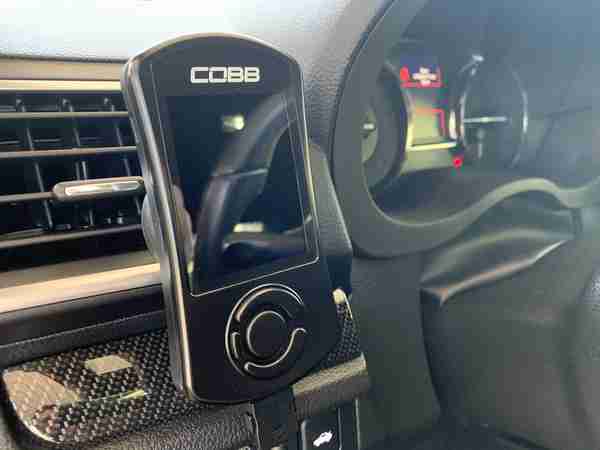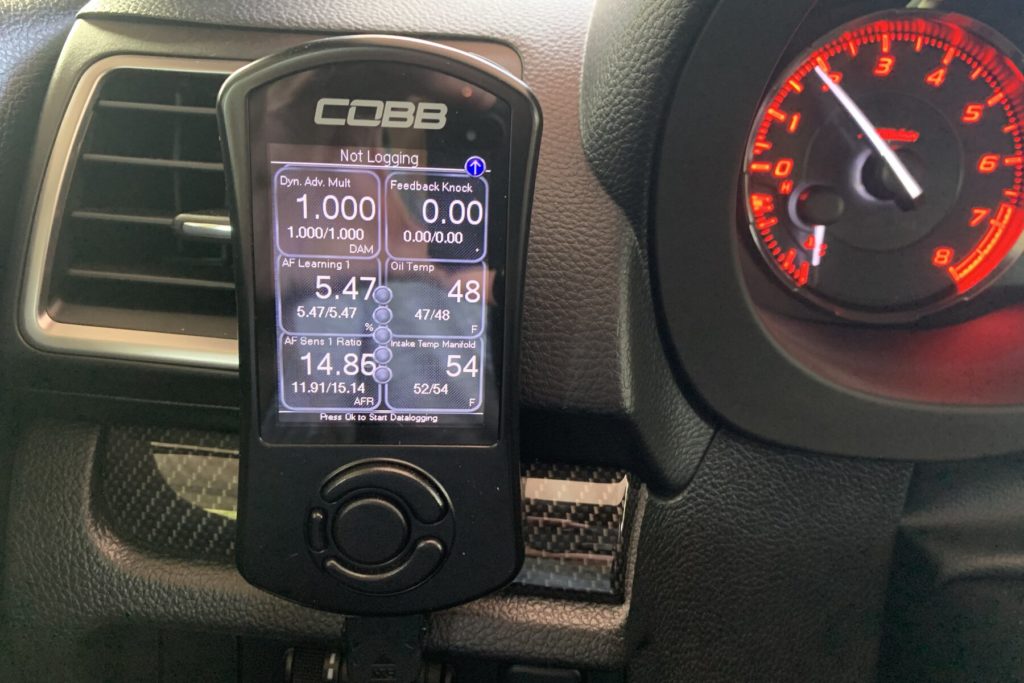If your Subaru WRX, WRX STI, Forester XT, or other turbocharged model is tuned and you have a Cobb AccessPort, you probably monitor some parameters related to knock, or at least have heard that you should. While many owners are worried when they see any knock, this isn't always a concern. In this article, we'll explain how Subaru's knock control system works, and how the various parameters are related.
While many people may be alarmed to see any knock showing on their AccessPort, some occasional knock is normal and not a cause for concern. The ECU is designed to keep the engine safe under varying conditions that may cause knock. Things like fuel quality and variation in ethanol content, altitude, and heat all affect how the engine runs. Under different conditions, some knock is bound to happen, and the ECU is designed to handle it.
There are three parameters related to knock control that most WRX owners monitor on their AccessPort. These are feedback knock, fine knock learning, and dynamic advance multiplier (otherwise known as DAM). We'll explain what each of these mean below and how they work together.
Feedback Knock
Feedback knock is the first place you'll see knock registered. It immediately responds to knock events. Your engine has a knock sensor mounted to it. This is essentially a piezoelectric microphone designed to pick up sounds from inside the engine. The ECU (engine control unit) is programmed to recognize the sound of a knock, based on some threshold of sound being exceeded.
When the ECU detects knock based on the signal from the knock sensor, you'll see this registered in feedback knock. The value refers to degrees of ignition timing advance.
The feedback knock correction will start with a small value (-1.41 degrees) and keep retarding timing until the ECU no longer detects a knock event. The ECU doesn't detect the severity of knock, just determines if knock is present. It retards timing in gradual steps until the knock stops. It then decays the value back to zero in gradual steps.
It's normal to have occasional knock that doesn't follow any sort of pattern, and the knock correction system is designed to handle that and keep your engine safe. Generally, seeing occasional feedback knock is nothing to worry about. Sometimes this is false knock, which can be caused the air conditioning compressor or anything loose in the engine bay. It can also be caused the EGR system while traveling at constant speeds. Values of -1.41 or -2.82 are normal to see while cruising.
If you see higher values like -4.20 or -8.44, this might be nothing if it's a very occasional random event. If you see large feedback knock values frequently, there may be a problem. It could be low quality gas, or there could be a problem that needs to be addressed with the car physically or in the tune.
One thing you can do to avoid knock is avoiding wide open throttle at low RPM or building full boost. It's best to gradually step on the throttle rather than flooring it right away. This can lead to a condition called low speed pre-ignition, which will register as feedback knock. In lower gears, you'll want to avoid flooring it below around 2.5k - 3k RPMs. At highway speeds in 5th or 6th gear, you'll want to increase this to around 3k - 4k RPMs.
If the ECU detects there's a pattern to the knock, and it's not just a one-time random event, it has additional knock control measures to deal with this. That's where fine knock learning comes into play.

Fine Knock Learn
If your ECU detects that knock is happening more frequently with some pattern, then it will apply fine knock learning. This value also indicates a number of degrees in ignition timing. The logic is that if knock is likely to happen under some combination of calculated load and RPM, then the ECU should pull some timing before it happens. This is better than waiting until knock happens, and then and using feedback knock correction.
Like feedback knock, it's not always a concern to see fine knock learn. It can be totally normal depending on the temperature, fuel quality, and your tune. If you're seeing feedback knock and you don't normally, first try filling up at a different gas station. It may be fuel quality that's causing the knock.
It's common to see fine knock learn, especially with off the shelf tunes, like the ones from Cobb and MAPerformance. While these tunes are a great improvement over the stock one, they're not tailored specifically to your car. A custom dyno tune or e-tune is always best and will get you the least knock, especially with stage 2 and beyond.
When fine knock learn correction is being applied, the ECU will gradually test if it's safe to return to normal by gradually advancing the ignition timing.
To clear the learned values, you must drive while hitting each RPM and load range that the ECU has recorded a value for. If it sees feedback knock again, it will keep the fine knock learn values. If you reset the ECU, these values will also be cleared, but some learned correction is normal. If there is a real problem, it should be addressed before resetting the ECU.
If the ECU is applying fine knock learn across a wide range, then it will reduce the dynamic advance multiplier. This is the final part of Subaru's knock control strategy.
Dynamic Advance Multiplier (DAM)
The dynamic advance multiplier is the ECU's last knock correction measure. This value isn't a number of degrees, but a multiplier. Dropping the DAM allows the ECU to globally pull timing.
The ECU has a table of dynamic advance values that determines how much ignition advance should be used. The current dynamic advance value is multiplied by the DAM. After this value is calculated, feedback knock correction and fine knock learn are added to get the final timing advance value.
With most flashed tunes, the DAM value starts at its max value. For most Subarus, including ones with an EJ25, or ones with an FA20, DAM ranges from 0 to 1. For 2.0 EJ models, it ranges from 0 to 16. (Source: Cobb Tuning). With the stock tune, this value starts below the maximum and works its way up when no knock is detected. On these 2.0 EJ models, DAM is sometimes referred to as IAM (ignition advance multiplier).
If the DAM drops below the default value, then it's something you should at least investigate. Don't be too alarmed, this doesn't mean your car has a serious problem necessarily! You should try to empty your gas tank and fill up with a known good source, and maybe check that all your bolts are tight if you've installed aftermarket parts. If you have an intake, then you could check if your AF Learning 1 (fuel trim) is inside of normal ranges and that everything is securely fastened.
Once the DAM has dropped and stabilized, the ECU will start to test if it's safe to raise back up gradually. You'll see positive values for your fine knock learn, showing how the ECU testing if advancing the timing is safe. When it does this, after a few attempts, if it doesn't detect any knock, it will start to raise the DAM up. While an ECU reset will clear DAM, it's not recommended to do this unless you've addressed the reason for the knocking.
Timing Advance Calculations
The final timing advance is calculated based on all of the three parameters we've described. Based on the logic described above, here are the equations the ECU uses to calculate how much timing advance should be used.
If your DAM ranges from 0 to 1 (most models), the current timing advance calculated like this:
Timing advance = (current dynamic advance max * DAM) + feedback knock + fine knock learn
For models where DAM ranges from 0 - 16 (2.0 EJ models), it's slightly different, since DAM is not represented as a decimal value:
Timing advance = (current dynamic advance max * (DAM/16)) + feedback knock + fine knock learn
Closing Thoughts
While it's a good idea to monitor knock on your tuned Subaru, you shouldn't panic if you see some knock. It's likely a random event or bad gas. Ruling these things out, we'd recommend getting a custom tune made if you're running an OTS tune, or contact your tuner otherwise. In general, you should be safe, and probably less anxious if you just put your AccessPort away in the glovebox.
Frequently Asked Questions
What causes feedback knock?
Feedback knock can happen randomly as a one-time event due to varying conditions in the environment. Bad quality gas can also cause knocking. Mechanical issues that may cause knock include bad MAF or front O2 sensors, boost leak, and excessive blow-by.
What does positive fine knock learn mean?
Positive fine knock learn means your car's ECU is testing to see if it's safe to raise the DAM. It does this after the DAM has dropped and stabilized. It then tests a more aggressive timing advance, and if no knock is detected, it will raise the DAM.
What should AF Learning 1 be at?
AF Learning 1 should generally be +/- 8%, but the closer to 0, the better. AF Learning 1 measures how much your ECU has learned to compensate for fuel to reach the target air-fuel ratio.
What is ignition timing advance?
Timing advance refers to the number of degrees before the piston reaches top-dead-center that the spark will ignite. Igniting the air-fuel-mixture when the piston is closer to top-dead-center helps to reduce knock at the cost of power.
What does advancing the timing mean?
Advancing the ignition timing means the spark is earlier, further from top-dead-center. This gives more horsepower but makes knock more likely.
What does retarding the timing mean?
Retarding the timing means the spark happens closer to top-dead-center. This reduces the chance of knock but also reduces the power output. When knock is detected, the ECU retards the timing.
What is low speed pre-ignition?
Low speed pre-ignition is an undesired early combustion event that direct-injected engines are susceptible to. It occurs during low engine speeds and high loads. You can avoid this by waiting to get into higher RPMs before you heavily accelerate. It's also important that you use the correct motor oils that are formulated to combat this issue. You'll want an SN Plus rated oil for DIT (direct-injected turbocharged) engines.

